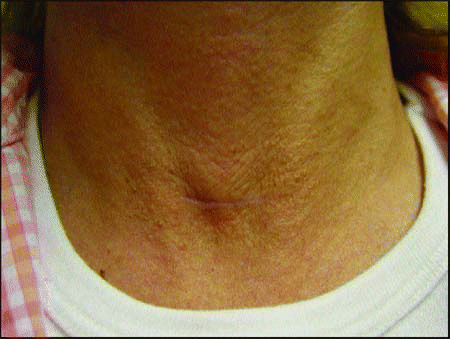Overall, the small incisions discussed in the Terris et al. article are now being applied more broadly to head and neck surgery, noted Dr. Stack. We’re making smaller incisions or no incisions at all, in the case of nasal endoscopic procedures, he said.
Explore This Issue
October 2007The very smallest incisions for thyroid surgery are possible if the suspect nodule is 25 mm or less and the gland is not significantly enlarged, said Dr. Terris. To create smaller incisions, he uses the harmonic scalpel, he said, adding that endoscopic thyroid surgery can generally be done through a 15- to 20-mm cut.
With endoscopic surgery, physicians can often make smaller incisions and deliver the thyroid outside the body for excision, rather than making the long cut required during open surgery, explained Phillip Pellitteri, DO, a head and neck surgeon in the Department of Otolaryngology and Head and Neck Surgery at Geisinger Medical Center in Danville, PA.
However, pulling the thyroid gland through a small incision can cause maceration and trauma to the skin, increasing the risk of hypertrophic scarring, noted Dr. Terris. Trimming the skin edges can allow the wound to heal properly, he said.
If you take damaged tissue and sew it together, it’s not going to heal as well and may form an unattractive scar, commented Dr. Stack, adding that freshening skin edges may be useful for other head and neck procedures in which the skin is stretched to gain visualization.
Patients with larger nodules or those who are too obese for endoscopic surgery may need to undergo MINET, said Dr. Terris, adding that this procedure usually requires a 3- to 6-cm incision. Dysphagia, which can be a side effect of MINET due to cutting the strap muscles, has not been a problem in study patients. We repair these muscles at the end of the operation, he explained.
Fortunately, scarring can still be minimal when using MINET, or even conventional surgery, as long as the incision is well-planned and closed properly, said Dr. Davis. Of course, outcomes are best in patients who have a good intrinsic ability to heal.
The ability of a scar to heal is based primarily on the patient’s health and how the surgeon puts the tissues back together, said Dr. Pellitteri. Large incisions can heal just as well as small incisions, he said.

Leave a Reply